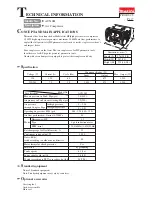
61
8. STANDARD COMPONENTS AND SUBSYSTEMS [Cooling Water]
8.3 Cooling Water
1. Cooling Water Quality
If a cooling tower (open-type circulatory cooling water
system) supplies the cooling water to the
DSP
, problems
such as corrosion, scale, and slime may be caused by: (1)
higher mineral content due to concentration, (2) contami-
nation by foreign matter like insects, and/or (3) produc-
tion of algae or bacterium. Use the cooling water of as
good a quality as possible.
①
When stopping the
DSP
, also stop the cooling water
flow. Open the petcock and the water drain valve to
drain the cooling water. Failure to do so may cause the
cooling water pipe to be iced and burst in winter
season. Failure to do so may also cause the air end
case to be overcooled and dewed with the condensate
internally; the cooling water jackets to be attached
with the scale.
②
Clean the cooling water subsystem (cooling water
jackets of the first- and second- stage air-ends, inter-
cooler, Aftercooler, and oil cooler) periodically.
2. Control of Cooling Water
The service life of the cooling water system depends on
water quality. If the cooling water quality is not good, the
cooler pipes can be corroded, or scale can be generated.
To avoid the problem, periodically sample the cooling
water used and subject it to quality inspection.
3. Quantity and Pressure of Cooling Water
The table below lists desirable cooling water quality that
is applicable to the open type circulatory system.
Water Relief Pet Cock
Water Drain Valve
■
Quantity and Pressure of Cooling Water
Model
DSP-132WN
DSP-145WN
DSP-160(V)WN
DSP-200WN
DSP-240(V)WN
Maximum Inlet Temperature
℃
(
℉
)
32 (90)
Total Flow Rate
ℓ
/min (cmf)
200 (7.1)
210 (7.4)
240 (8.5)
300 (10.6)
330 (11.7)
Minimum Pressure Differential
(between inlet and outlet)
MPa (psi)
0.10 (15)
Temperature Differential
(between inlet and outlet)
℃
(
℉
)
about 10 (50)
Water Pressure
MPa (psi)
0.15 (22) to 0.49 (71)
■
Cooling Water Quality
No
Item
Make-up Water
System Water Used
Problem
Corrosion
Scale
1
2
3
4
5
6
7
8
9
10
11
12
13
14
15
pH [at 25
℃
]
Electrical Conductance [at 25
℃
] (ms/m)
Chloride Ion Cl
ー
(mgCl
ー
/ liter)
Sulfuric Acid Ion SO
4
2
ー
(mgSO
4
2
ー
/
ℓ
)
Acid Consumption [at pH 4.8] (mgCaCO
3
/
ℓ
)
Total Hardness (mgCaCO
3
/
ℓ
)
Calcium Hardness (mgCaCO
3
/
ℓ
)
Ferrous Substance (mgFe/
ℓ
)
Sulphur Ion S
2
ー
(mgS
2
ー
/
ℓ
)
Ammonium Ion NH
4
(mgNH
4
+
/
ℓ
)
Ionizing Silica SiO
2
(mgSiO
2
/ liter)
Isolated Carbonic Acid CO
2
(mgCO
2
/
ℓ
)
Nitric Acid Ion NO
3
ー
(mgNO
3
ー
/
ℓ
)
Organic Substance (KMnO
4
Consumption) (mg/
ℓ
)
Turbidity (mg/
ℓ
)
6.0 to 8.0
less than 30
less than 50
less than 50
less than 50
less than 70
less than 50
less than 0.3
Not detected
less than 0.1
less than 30
less than 4
less than 0.5
less than 10
less than 10
6.5 to 8.0
less than 80
less than 200
less than 200
less than 100
less than 200
less than 150
less than 1.0
Not detected
less than 1.0
less than 50
less than 4
less than 0.5
less than 10
less than 10
○
○
○
○
−
−
−
○
○
○
−
○
○
○
○
○
○
−
−
○
○
○
○
−
−
○
−
−
○
○
Notes:
1. System Water is the one that passes through a heat exchanger of circulatory or non-circulatory system.
Make-up Water is the one that is supplied to a cooling tower.
2. Above No. 1, 2, 4, 5,
7
〜
12 are based on the standard: JRA-GL-02-1994.JRA:
(
Japan Refrigeration and Air Conditioning Industry Association
)
3. The above criteria does NOT give any assurance of trouble-free or problem-free conditions due to other and time-depending factors but the minimum
requirement.
Performance of Aftercooler and oil cooler var-
ies depending on the extent of throttling the
stop valve at the extent of throttling the stop
valve at the cooling water inlet and outlet.
For controlling the cooling water flow rate, use
the stop valve at the outlet leaving the stop
valve at the inlet fully opened.
CAUTION
















































